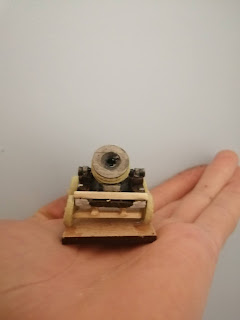Tuesday, 1 December 2020
Blood Bowl Pitch Case Part 2
Saturday, 28 November 2020
Blood Bowl Pitch Case Part 1
Thursday, 29 October 2020
Conall Beag
Saturday, 10 October 2020
Sebastopol Mortar (build)
I've long wanted to build an Ethiopian army for Hordes of the Things. Recently, I've been doing some research into what such an army might look like. I ended up reading about "Sebastopol", a huge mortar commisioned by Tewodros II in the 1860s.
The gun weighed 6.7 tons and could fire around half a ton of ammunition at a time! Although an indication of its power, Sebastopol's great weight was its undoing. As far as we know, it was never fired in battle. It was simply to heavy to be mobile.
"Sebastopol" is a strange name. It refers to a city in Crimea, but I couldn't find any information as to why a mortar was given this name. Tewodros fought against the British, who had previously besieged Sebastopol. However, this was a British victory, so the name of the weapon probably wasn't ironic or insulting.
This history is very inspiring, so I started thinking about how I would include it in my future army. It will be classed as Artillery, possibly as a General element for extra power. I imagine that as being Tewodros cheering on his creation!
I remembered I had a 28mm scale mortar I got free with some Alternative Armies figures. I checked it for scale beside some 15mm figures and it was quite accurate to the size of Sebastopol, so the conversion work began!
Tuesday, 8 September 2020
The Silver Pinnacle Slayers
Monday, 7 September 2020
Pegaso Ronin Bust
For my birthday this year, I got a very nice resin bust from Pegaso. Initially I wanted to paint him as Musashi Miyamoto, a samurai of almost legendary renown. I decided against this later on, instead employing a style inspired by the music of Shing02 and artwork from Samurai Champloo.
I tried out some new techniques on this figure. I wanted to create a "Rembrandt lighting" effect. This means that half the face is hit by light, while the other side is in shadow. I'm happy with the result, but I think I should have increased the contrast between the light and dark areas.
The pattern on the collar represents a bamboo forest under a rising sun, and is repeated around the figure.
The image on his back was painted in a cartoon style, inspired by the visuals of Samurai Champloo.


















































